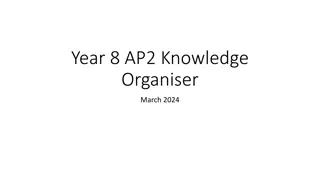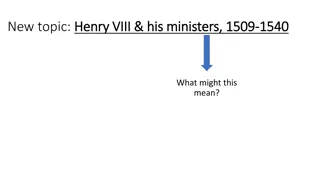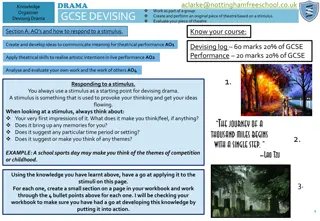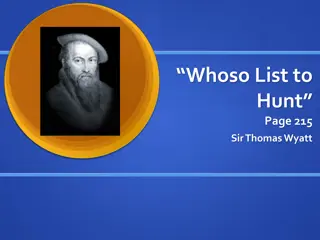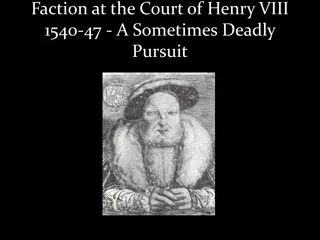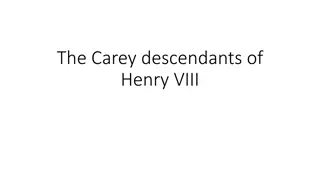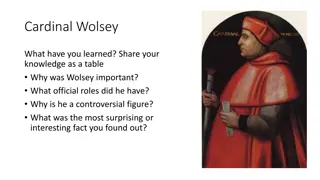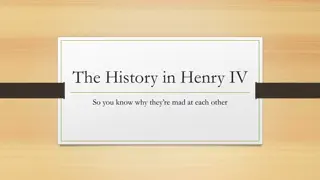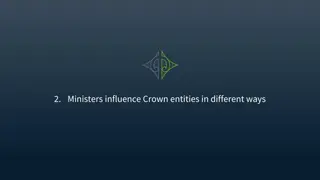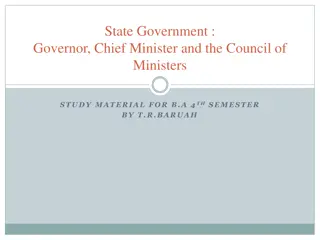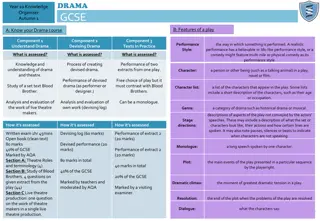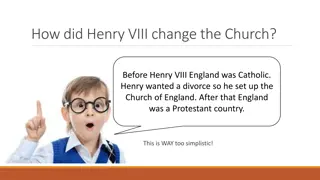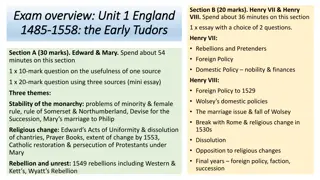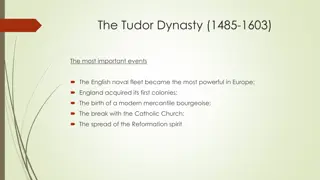
Henry VIII and Wolsey: Renaissance Prince and Chief Minister
Explore the reign of Henry VIII and the rise of Cardinal Wolsey as Chief Minister, focusing on key events, reforms, and foreign policy initiatives. Discover Henry's strengths and weaknesses, Wolsey's rise to power, main reforms, and foreign policy successes and challenges. Dive into the dynamics of Tudor England during this transformative period.
Download Presentation

Please find below an Image/Link to download the presentation.
The content on the website is provided AS IS for your information and personal use only. It may not be sold, licensed, or shared on other websites without obtaining consent from the author. If you encounter any issues during the download, it is possible that the publisher has removed the file from their server.
You are allowed to download the files provided on this website for personal or commercial use, subject to the condition that they are used lawfully. All files are the property of their respective owners.
The content on the website is provided AS IS for your information and personal use only. It may not be sold, licensed, or shared on other websites without obtaining consent from the author.
E N D
Presentation Transcript
Henry VIII & His Ministers Knowledge Organiser 1. Chapter 1 HVIII & Wolsey, 1509-29. 1.1 HVIII, Renaissance Prince 1.2 The rise of Wolsey & his policies Key Words Henry VIII s accession to the throne was greeted with enthusiasm. Some described him as a Renaissance Prince. For 15 years Wolsey dominated Henry s government. The nobility didn t like Wolsey. He made domestic and financial reforms. His position became weaker as he abused his power. 1 10. Jousting Sporting contest on horseback try to knock to ground. 11. Accession Becoming king or queen. 12. Betrothed Formal engagement to marry. Key Events 13. Royal Progress Royal tour of the kingdom. To be admired & to meet people. 2 1509 Henry VIII becomes king 14. Renaissance Revival of European art and culture. 3 1515 Wolsey becomes Chief Minister, Cardinal & Lord Chancellor 15. Courtly love Elite entertainment noble gentlemen attempted to win the hearts of women through songs, poetry and quests. Women pretended they were uninterested. 4 1518 Wolsey made Papal Legate 5 1525 Amicable Grant 16. Lord Chancellor Most important post in Henry s government, advised king on all matters 6 1526 Eltham Ordinances 17. Archbishop of York second most important religious appointment in England, after the Archbishop of Canterbury. Key Questions 18. Cardinal Senior leader in the RC Church. 7. Did Henry have the right character & outlook for ruling England. List his strengths & weaknesses. Strengths: Deeply religious. Confident. Alpha male!! Popular. Talented sports, jousting, musical. 19 Pope Head of the RC Church. 20. Moveable goods Possessions that could be moved from one location to another e.g. furniture, livestock. Weaknesses: Stubborn. Some viewed him as harsh. Would not compromised. Too focused on war. Did he delegate too much to his advisors? Diplomatic? 8. How and Why did Wolsey rise to power? Was charming and gifted gained his degree aged 15. Became his college s treasurer in Oxford and built up skills & undertook huge rebuilding project showed ambition and arrogance. 21. Royal household Membership of nobles and servants ensured king was provided with food, clothing and spiritual guidance. 22. Privy Chamber Small group of King s closest noble friends. Looked after his personal needs. Huge influence. 9. What were Wolsey s main reforms in England? Were they successful? Justice: Wolsey used the Star Chamber, a royal court set up by Henry VII. Many people thought he wanted revenge on the upper classes, who had often treated him badly because of his low birth status. He also punished those he had a grudge against. The Amicable Grant 1525: Henry VIII wanted to invade France but had no money. Wolsey passed a tax without asking parliament. People had to pay 1/6 of their income they had 10 weeks to find the money. In 1525 men in Suffolk fought back. The collection was stopped. Wolsey did not attempt to pass taxes again. Enclosure: Enclosure meant fencing off land and it caused poverty in rural areas. In 1517 he set up an enquiry into enclosure. He brought 260 court cases against landowners. He became very unpopular amongst wealthy landowners of England. In 1523 angry landowners stopped him from investigating further. Wolsey achieved very little and Enclosure continued to take place. The Eltham Ordinances: The King s palaces were dirty, people were badly behaved and money was wasted. So Wolsey drew up a list of rules known as the Eltham Ordinances. These included: sacking servants who were sick or not needed, meals were at set times, dogs were banned. 23. Royal Council Group of advisers chosen by the king and selected mainly from nobility and church. 24. Court Body of people made up of the monarch s key servants, advisers and friends. Courtiers. 25. Parliament Made up of the House of Lords and the House of Commons. Passed laws & taxation. 26. Justices of the Peace Kept law and order. 27. Enclosure Fencing off land. 28. Subsidy A tax. 29. Amicable Grant A new direct tax in 1525. Caused resentment. 30. Eltham Ordinance Reforms of the domestic and political aspects of household.
Henry VIII & His Ministers Knowledge Organiser 2. Chapter 1 HVIII & Wolsey, 1509-29. 1.3 Wolseys Foreign Policy. 1.4 Wolsey, Catherine, the succession and annulment. Key Words 1 Wolsey managed to increase English influence in Europe. Field of the Cloth of Gold, Treaties of London and Bruges were successes. BUT England struggled to compete with France and the HRE. Wolsey failed to secure an annulment and this led to his downfall. Key Events 10. Habsburg Royal Catholic family that ruled Spain during Henry VIII s reign. 11. Holy Roman Empire Group of different states and kingdoms covering a large area of central Europe. 12. Trade embargo Hostile act of cutting trade links with another country. 13. Consummated Confirming a marriage by having sex. 2 1518 - Treaty of London 14. Regent A person who governs the kingdom in the king s absence. 3 1520 Field of Cloth of Gold successful but expensive. 15. Annulment A legal term declaring that a marriage was never valid, and therefore never existed. Only granted by pope. 1522 25 2nd French war Failure. 4 5 1525 29 Support for France. Alliance. War against Charles V. Divorce = focus. 16. Praemunire Treason by a member of the clergy as a result of working in the interests 6 1530 Wolsey s fall from power & died. 17. Battle of the Spurs 1515 Henry defeated French army. Captured Therouanne & Tournai. Key Questions 18. Treaty of London 1518 Aimed to end warfare with England, France & Spain. Non aggressive foreign policy. 7. Wolsey s foreign policy failed to turn Henry into a leading player in Europe. Argue FOR & AGAINST. FOR: There had been big failures. War against France 1522-25. Treaty of Westminster 1527. War against Charles V 1528. Treaty of Cambrai 1529. War was very expensive. 19 Field of Cloth of Gold 1520 Henry met Francis I of France. Wanted to show off. Great success. AGAINST: There had been successes. Treaty of London, Field of Cloth of Gold, Treaty of Bruges. 20. Treaty of More 1525 Once Charles had won at Battle of Pavia he didn t repay Henry for his help. England sided with France and signed Treaty of More. 8. Which reason do you think was the most important in encouraging Henry to seek an annulment his need for a son, moral concerns over his marriage or his love for Anne Boleyn? -He believed the marriage to be against God s will (moral concerns) 21. Treaty of Westminster 1527 Wolsey helped organize League of Cognac. Alliance w - He wanted a new wife and a male heir 22. Treaty of Cambrai 1529 Francis made peace with Charles V. Wolsey informed at last minute. England no longer treated as an ally. - He had fallen in love with Anne Boleyn 23. Succession Next in line 24. Catherine of Aragon Henry s first wife. 25. Anne Boleyn Henry s second wife. 9. Wolsey s failure to gain an annulment for Henry was the main reason why he fell from power in 1529. How far do you agree? AGREE: Failed to weaken the grip Charles V had over Pope. Wolsey as Cardinal was expected to have sway over the Pope but was unable to persuade him. Henry was disappointed with Wolsey s failure to gain divorce. The rise of the Boleyn faction meant pressure on Henry grew. 26. Cardinal Campeggio Involved in the divorce case. 27. John Fisher Supported Catherine. He opposed the annulment. 28. Thomas More Advisor to the king. Opposed the annulment. DISAGREE: Wolsey was unable to control nobles in court. Weakened his power base. He had few allies. Foreign policy failures weakened him. Wolsey hailed to acknowledge and deal with the problems he faced. 29. Charles V HRE 30. Leviticus Argument used by Henry to gain an annulment. Bible extract.
Henry VIII & His Ministers Knowledge Organiser 3. Chapter 2 HVIII & Cromwell, 1529-40. 2.1 Cromwell s rise to power, 1529-34. 2.2 Cromwell and the king s marriages. Key Words 10. Adultery When a married person has sex with someone else. 1 Henry wanted huge religious and government reforms. Cromwell helped to gain Henry his divorce from Catherine of Aragon and worked as his chief minister from 1533-40. Henry married Anne Boleyn in 1533. In May 1536, she was found guilty of treason and adultery and was beheaded. By 1536, Henry was in love with Jane Seymour. Cromwell played a key role in bringing down Anne Boleyn. Key Events 11. Papal bull Document issued by the Pope view / instructions. 12. Dissolution of the monasteries Closure of monasteries by Henry VIII 1536-40. 13. Thomas Cromwell Henry s chief minister. 2 1529 Wolsey s fall from power. Cromwell MP for Taunton. 14. Adviser Gave advice. 3 1533 Cromwell = Henry s chief minister. 15. MP Member of Parliament. 4 1535 Cromwell Vicegerent in Spirituals / Vicar general Church reform. 16. Royal Council Henry s circle of trusted advisors. 5 1536 Cromwell = Lord of the Privy Seal. 17. Thomas More A councillor to Henry VIII, and Lord High Chancellor of England. 6 1536 Catherine of Aragon died. Anne Boleyn executed. Married Jane Seymour. Dissolution of monasteries 1536-40. 18. Anne Boleyn Crowned queen June 1533. Key Questions 19 Act in Restraint of Appeals 1533 Became basis of granting Henry s divorce. 7. Why did Henry want to divorce Catherine of Aragon? Validity of the marriage in the eyes of God. Loved Anne Boleyn. Wanted a son / male heir. Marriage was curded. 20. Chancellor of the Exchequer 1533 Leading role in Chancery (financial). 21. Master of the Rolls 1530 Senior position in legal system. 8. Explain why Cromwell rose to become Henry s chief minister. Cromwell s work with Wolsey The annulment Gained complete trust of Henry VIII. Secured divorce from Catherine of Aragon. Ambitious. Experience with Wolsey. Focused. Cromwell s solution was radical and involved transferring the powers held in Rome to the king. Parliament was used Act in Restraint of appeals. Power with church and Crown not Rome. 22. Break with Rome Henry VII head of the Church & State 23. Jane Seymour Married Henry 30 May 1536. 24. Treason Plotting against king / Queen. 25. Execution Killed. 26. Protestant A religion separate from Catholic church. 9. How much responsibility should be attached to Cromwell for the fall of Anne Boleyn? Anne Boleyn fell from power as she failed to provide Henry with a son. She was suspected of adultery. By 1536, Henry was in love with Jane Seymour. Cromwell played a key role in bringing down Anne Boleyn by gathering evidence against her. 27. Succession Act Gave king power to appoint any successor at any time. 28. Edward VI Jane Seymour s son. 29. Pilgrimage of Grace Rebellion in 1536. 30. Henry Fitzroy Henry s illegitimate son.
Henry VIII & His Ministers Knowledge Organiser 4. Chapter 2 HVIII & Cromwell, 1529-40. 2.3 Cromwell and government, 1534-40. 2.4 The fall of Cromwell. Key Words 10. Bureaucracy Way of managing a country. 1 Cromwell wanted to improve the way Henry s kingdom was governed. He developed a smaller Privy Council, Court of Augmentations and Court of First Fruit and Tenths. Act of Union 1536. Role of Parliament increased. Henry married Anne of Cleves but only lasted 6 months. Henry fell in love with Catherine Coward. Cromwell fell from power. 11. Statute Law Act of Parliament agreed by both houses & signed by the monarch. 12. Act of Annates Banned the payment of a tax to Rome from the salaries of clergy. Key Events 13. Heresy Religious view against official opinion. 2 1536 Act of Union. Court of Augmentations. 14. Act of Attainder Act of Parliament that declares a person guilty of treason. 3 March 1539 Marriage negotiations with Cleves family. 15. Cromwell Key minister to Henry VIII. 4 January 1540 Henry VIII married Anne of Cleves 16. Royal Council important advisory body to the king day to day running. 5 1540 Court of First Fruit & Tenths 17. Privy Council 20 permanent advisers - lawyers / professionals. 6 July 1540 Cromwell executed. Henry marries Catherine Howard. 18. Council of the North Royal body first set up in 1472 to improve how the north of England was governed. Was strengthened. Maintained law and order. Key Questions 7. The main changes to Henry VIII s system of government and finance in the years 1534-40 was a greater role for Parliament. How far do you agree? Royal Council Financial system New government departments. E.g. Court of Augmentation and Court of First Fruit and Tenths. 19 Act of Union 1536 Wales formally a part of England. 20. Court of Augmentations 1536 dealt with property and income gained from dissolution of monasteries. Parliament changes - Statute Law Henry s divorce. Ensured MPs were well managed. Pressured people to get them to vote the way he wanted. Government departments. 21. Court of First Fruit & Tenths 1540 collected tax from clergy that had previously been sent to Rome. 22. King in Parliament King with approval of House of Commons & House of Lords. 8. A need for a son, or the need to protect his kingdom. Which reason do you think most influenced Henry in his decision to marry Anne of Cleves & why? Cromwell encouraged Henry to remarry. England needed allies More religious reform without opposition from a Catholic Queen. Henry fancied her based on her portrait. Henry s 4th wife. 23. Anne of Cleves 24. Cleves Small kingdom in north of HRE. 25. Duke of Norfolk Thomas Howard competed with Cromwell for influence over Henry VIII. 9. Thomas Cromwell fell from power because of the actions of the Duke of Norfolk. How far do you agree? MARRIAGE: Whilst Cromwell survived the fall of Anne Boleyn, the fiasco of the Cleves marriage weakened Cromwell s relationship with Henry at a crucial time. RELIGION: Cromwell s use of his power as Vice-Regent by producing the Ten Articles and Bishops Book went much further than making Henry Head of the Church. This clashed with Henry s conservative outlook and the Six Articles in 1539 reversed many of these changes. ENEMIES: With his position weakening, rivals led by Gardiner and Howard gathered information against him and presented it to the King. 26. Catherine Howard Lady in waiting to Anne of Cleves. Young and flirty! 27. Consummated Complete a marriage by having sex. 28. Excommunicated Banished / sent away / removed. 29. Allies Friends. 30. Protestantism The faith, practice, and Church order of the Protestant Churches.
Henry VIII & His Ministers Knowledge Organiser 5. Chapter 3 The Reformation & its impact, 1529-40. 3.1 The Break with Rome. 3.2 Opposition to, and impact of the Reformation, 1534-40. Key Words Henry started his reign as a strong Catholic. But broke away to secure his divorce from Catherine of Aragon. 1534 Act of Succession & Act of Supremacy. Oaths & treason law. Opposition was limited. 1534-40 further Protestant direction English Bible. 1 10. Sacraments Special church ceremonies baptism / marriage. 11. The Eucharist Bread and wine in church service. Last supper. 12. Transubstantiation Belief that bread and wine is transformed into body / blood Jesus. Key Events 13. Indulgences Certificate issued by Catholic church forgiveness. 2 1533 Elizabeth Barton arrested and interrogated 14. Pilgrimage Journey for religious reasons. 3 1534 Act of Succession, Supremacy, Treason Act. Barton executed. 1536 1st set of Royal Injunctions issued to clergy. 4 15. Anti-Clericalism Opposition to clergy. 1538 2nd set of Royal Injunctions issued by Cromwell. 5 16. Vicegerent King s deputy. Responsibility for running church. 6 1539 Six Articles (Catholic Doctrine) 17. Celibate unmarried / no sex. Key Questions 18. Doctrines Teachings of the church. 7. Which do you think was more significant in increasing Henry s power: The Act of Supremacy or Act of Succession? Why? Act of Supremacy England no longer under Pope s control. Henry head of English Church. Henry now had powers previously held by the Pope. BUT its practical significance must not be overstated. In practice, the pope had played a very small part in the affairs of the English church. 19 Protestantism A religion separate from Catholic church. 20. Martin Luther Protestant Reformer. 21. Reformation Reform of the Catholic Church. 22. Vestments Ornate priest clothing. Act of Succession - Only children of Henry s second marriage would inherit throne. It completely changed the order of the succession. It established Anne Boleyn s position as queen by law. It was a significant step towards the final break with Rome. 23. Richard Hunne Baby son died. Refused to pay mortuary fees. Sued and arrested. Died in cell. Murder???? 24. Act of Succession 1534 Only children of Henry s second marriage would inherit throne. 8. Was the opposition to the break with Rome a serious threat to Henry? Why? 3 key figures opposed Reformation: Elizabeth Barton, Thomas More, John Fisher. Most people accepted religious changes. 25. Act of Supremacy 1534 England no longer under Pope s control. Henry head of English Church. 26. Break with Rome Henry moving away from the Church in Rome. 9. In the years 1534 40 the English Church changed very little. How far do you agree? English church pushed towards a more Protestant direction English Bible. Superstitious practices, e.g. praying to relics were banned. Act of Supremacy. The Six Articles. BUT Many elements of the Catholic Church service remained, e.g. traditional mass. 27. Oath of Succession Supported Anne Boleyn as Henry s Queen. 28. Treason Act 1534 Death to anyone denying royal supremacy. 29. Elizabeth Barton Claimed Virgin Mary had appeared in vision and cured her. 30. John Fisher Challenged Henry. Executed for treason in 1535.
Henry VIII & His Ministers Knowledge Organiser 6. Chapter 3 The Reformation and its impact, 1529-40. 3.3 The dissolution of the monasteries. 3.4 The Pilgrimage of Grace, 1536. Key Words 1 Monasteries provided care for the sick and educational work. Between 1536-40 all of England's monasteries were closed down. Henry saw them as a source of wealth. Had an impact on many. Henry s religious changes were unpopular in the North. Led to Pilgrimage of Grace. Uprising failed because pilgrims trusted and negotiated with Henry. Henry didn t keep promises & in 1537 executed the rebel leaders. Key Events 10. Dissolution Get rid of. 11. Monasteries Religious houses. 12. Valor Ecclesiasticus Survey into church wealth. 13. Pilgrimage of Grace Uprising against closure of monasteries. 2 1535 Valor Ecclesiasticus 14. Religious contemplation Spent time thinking about ways to serve God. 1536 March 1st Act of dissolution of monasteries 3 4 1536 October-December Pilgrimage of Grace 15. Monk Religious person 5 1538 40 voluntary dissolution of large monasteries 16. Nun Religious person. 1539 2nd Act for dissolution of monasteries passed 6 17. Abbeys Larger rural institutions. 18. Priories / nunneries Medium sized houses. Key Questions 19 Friaries Smaller houses. 7. Explain why Henry dissolved the monasteries. Valor Ecclesiasticus Survey into church wealth. Money to finance wars. Protect England. Lower taxation. Use land to gift to gentry to increase support for Henry. Cromwell s commissions 1535 Moral state of monasteries. 20. Visitations Official inspections. 21. Compendium compertorum Findings / report. 22. Cultural vandalism Destruction of monastic buildings. 8. Overall, do you think there were more winners than losers as a result of the dissolution of the monasteries? Winners = Henry VIII became richer. Religious reformers / Protestants. Those able to buy monastic land / estates. 23. Robert Aske Leader of Pilgrimage of Grace rebellion. Losers = Those who relied on monasteries, e.g. poor & sick. Poverty rose. Nuns. Monks. Lost accommodation, food, companionship. 24. 1534 Subsidy tax Tax. Led to Pilgrimage of Grace. 25. 1536 Statute of Uses Tax on landed inheritances. 26. Pontefract Articles List of 24 demands. 9. The Pilgrimage of Grace was badly led. How far do you agree? Explain your answer. Robert Aske inspirational leader. Well armed rebels. Pontefract Articles. BUT decided to trust Henry. Misplaced faith. Hanged. 27. Nicholas Melton Lincolnshire Captain Cobbler. Rebel leader. 28. Thomas Howard, Duke of Norfolk In command of army. Negotiated with rebels. The agreement at Doncaster Negotiated. Accepted king s offer. Henry didn t keep to the agreement. 29. Rebel Goes against something. 30. Uprising Rebellion / attempt to take control.


